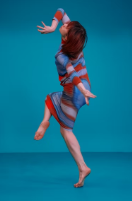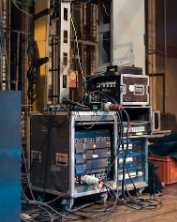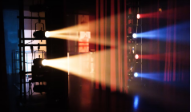The standards for Theatre Arts I enable students to participate in a creative processes of creating, refining. producing, and performing theatre. Students will analyze, interpret, and evaluate dramatic literature and theatrical works. The course emphasizes foundational concepts, ensemble work, and skill development and provides theatrical opportunities for students to determine areas of personal interest. Introduction to Theatre Arts offers students a general overview of theatre and its use and effect in and on culture. Students will be offered the opportunity to act, mime, improvise, design for the stage, read plays, discover theatre history and explore career options in the field of theatre. Students will also be encouraged to attend live theatrical productions. This course is a prerequisite for all other Theatre Arts course offerings.
Essential Question: What is the art of theatre?
|
Quarter |
Quarter 1 |
Quarter 2 |
Quarter 3 |
Quarter 4 |
|
Unit Title |
Expression & the Art of Theatre |
Opening the Tool Box |
It Takes a Village |
Turning on the Spotlight |
|
Image Cue |

|

|

|

|
|
Focus of the Story |
We begin by exploring the essence of theatre; how plot, character, dialogue, thought, sound and spectacle make a dramatic production that creates another universe. |
Continuing to build on the elements of theatre includes exploring the techniques and tools of actors, including voice and movement. |
Next, we take a peek behind the curtain and examine the jobs performed by those off-stage, including directors, designers and technicians. Identifying individual jobs provides opportunities to apply our learning. |
We end the year putting it all together and applying our learning by assuming the roles of behind the stage, on-stage, or front of house in a culminating project. |
|
Transfer Goals |
Understand and apply creative processes to guide the development of ideas, original works, and theatre performance. Understand and find meaning in theatre as a form of community engagement through involvement as a performer, supporter, advocate, and audience member. Explore and connect personal interests, experiences, and aspirations through vocation, advocacy, and arts patronage. |
Understand and apply creative processes to guide the development of ideas, original works, and theatre performance. Analyze, interpret, and evaluate theatrical works from a variety of cultures. Understand and find meaning in theatre as a form of community engagement through involvement as a performer, supporter, advocate, and audience member. Explore and connect personal interests, experiences, and aspirations through vocation, advocacy, and arts patronage. Use theatre literacy to demonstrate understanding of the elements of theatre and the ways they inform artistic performance and creative expression. |
Understand and apply creative processes to guide the development of ideas, original works, and theatre performance. Analyze, interpret, and evaluate theatrical works from a variety of cultures. Understand and find meaning in theatre as a form of community engagement through involvement as a performer, supporter, advocate, and audience member. Use theatre literacy to demonstrate understanding of the elements of theatre and the ways they inform artistic performance and creative expression. Use technology as a strategic mechanism for improving theatre literacy and improving theatrical performance. |
Understand and apply creative processes to guide the development of ideas, original works, and theatre performance. Analyze, interpret, and evaluate theatrical works from a variety of cultures. Understand and find meaning in theatre as a form of community engagement through involvement as a performer, supporter, advocate, and audience member. Explore and connect personal interests, experiences, and aspirations through vocation, advocacy, and arts patronage. Curate a portfolio of accomplishments, experiences and performance materials exhibiting oneself as an artist. Use theatre literacy to demonstrate understanding of the elements of theatre and the ways they inform artistic performance and creative expression. Use technology as a strategic mechanism for improving theatre literacy and improving theatrical performance. |
|
Learning Targets |
I can view theatre as a unique art form. I can integrate elements of other art forms into live theatre. I can display appropriate audience etiquette based on the theatrical production and venue. I can make a show unique based on interaction between the audience and performers. I can dictate performance and technical aspects of a production based on the type of stage in use. I can share the theatrical process. I can display safety (emotional, intellectual, physical and environmental) as a multifaceted concept. I can develop cooperative skills by participating in theatre activities. I can differentiate between critiquing and criticizing. I can incorporate the basic elements of drama using plays from all time periods and cultures. I can identify similarities and differences between dramatic literature and other literary genres, art and media forms. I can achieve a natural execution of movement techniques through practice. I can use effective movement techniques to stay open (visible) to the audience. |
I can derive content for a performance/ I can improvise by thinking on my feet during a spontaneous exchange. I can communicate by using acting and speech. I can produce a quality vocal tone by using proper breathing and articulation. I can improve my performance abilities by relaxing and using vocal exercises. I can change the meaning of lines through different vocal choices. I can create characters by employing a variety of techniques and skills. I can make my portrayal of a role unique by bringing in my own life experiences. I can identify each character’s purpose in a play. I can problem solve creatively as a primary tool for working on scripts. |
I can apply the director’s vision and concept to make a production of the same theatrical piece unique. I can present a unified vision in a production by applying certain “rules of participation” as established by the director and actors. I can contribute to the tone and meaning of a production using the theatrical environment (set, lights, costumes, sound, makeup, and props.) I can create an appropriate theatrical environment for each theatrical work. I can collaborate with others in the theatrical process. I can make connections between technical theatre and the environment. I can build performance readiness by preparing and rehearsing as part of an ongoing process. I can help the production process by being open to suggestions. I can help the creative process by exhibiting trust and confidence. I can participate in a collaborative process by acting. I can get a working feel of the production by participating in tech/ dress rehearsals with the production team (cast and crew.) |
I can provide adequate information and acknowledge the target audience as part of a successful marketing campaign I can interpret a playwright’s material as a response and relation to their era. I can use technology to continually transform the capabilities of live theatre. I can identify a multitude of styles and traditions in theatre that are reflective of, and affected by, culture, time and place. I can identify all elements of the arts as part of a theatrical integration (dance, visual arts, theatre, literature.) I can collaborate with others as part of the production process. I can identify responses to theatre as being subjective. I can appreciate a performance despite what my personal tastes may be. I can transfer my skills learned through theatre to other areas of my life |
